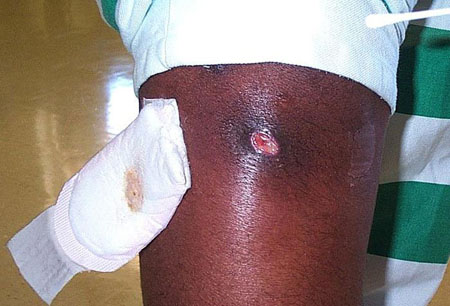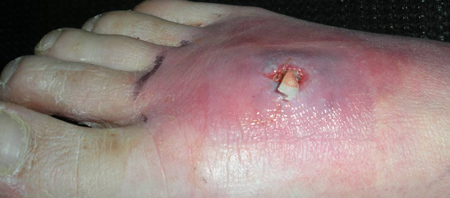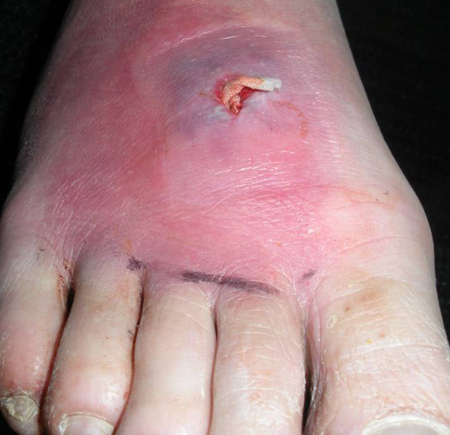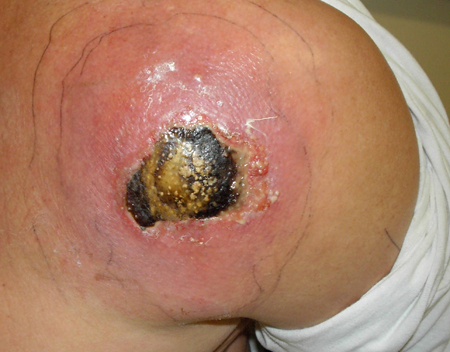History and exam
Key diagnostic factors
common
erythematous skin lesions or pustules, in single or multiple forms
Common presentation of community-associated MRSA.
Commonly mistaken for insect bites or folliculitis.
Central ulceration is sometimes present. [Figure caption and citation for the preceding image starts]: A common ulcerative skin lesion secondary to MRSA on a patient's armPublic Health Image Library, CDC website [Citation ends]. [Figure caption and citation for the preceding image starts]: Cutaneous abscess on the foot post-packing, caused by MRSA (side view)Major Kirk Waibel MD, from the Public Health Image Library, CDC website [Citation ends].
[Figure caption and citation for the preceding image starts]: Cutaneous abscess on the foot post-packing, caused by MRSA (side view)Major Kirk Waibel MD, from the Public Health Image Library, CDC website [Citation ends].
irritation or pain at indwelling catheter site
Patients with indwelling catheters may also have fever, chills, and signs of bacteremia.
This may accompany erythema or exudate at the catheter site.
uncommon
heart murmur and other signs of endocarditis
May indicate endocarditis.
Less commonly, there may be Roth spots (retinal hemorrhages), Janeway lesions (nontender, small erythematous or hemorrhagic macular or nodular lesions on the palms or feet), or subungual splinter hemorrhages.
Other diagnostic factors
common
infection unresponsive to penicillins
MRSA should be considered in patients not responsive to penicillin antibiotics.
This is especially true for skin and soft-tissue infections, which are the most common forms of MRSA infection.[3]
history of a presumed spider bite
This is a very common presentation of community-associated MRSA.
Patient presents with a nodular, abscessed, or ulcerated lesion with initial presentation as sharp pain and assumed to be a spider bite.
No spider or puncture marks are found.[3]
abscess formation
Can occur with any staphylococcal infection. [Figure caption and citation for the preceding image starts]: Cutaneous abscess on the foot post-packing, caused by MRSA (side view)Major Kirk Waibel MD, from the Public Health Image Library, CDC website [Citation ends]. [Figure caption and citation for the preceding image starts]: Cutaneous abscess on the foot post-packing, caused by MRSA (front view)Major Kirk Waibel MD, from the Public Health Image Library, CDC website [Citation ends].
[Figure caption and citation for the preceding image starts]: Cutaneous abscess on the foot post-packing, caused by MRSA (front view)Major Kirk Waibel MD, from the Public Health Image Library, CDC website [Citation ends]. [Figure caption and citation for the preceding image starts]: Cutaneous abscess caused by MRSAGregory Moran MD, from the Public Health Image Library, CDC website [Citation ends].
[Figure caption and citation for the preceding image starts]: Cutaneous abscess caused by MRSAGregory Moran MD, from the Public Health Image Library, CDC website [Citation ends].
fever
May accompany signs and symptoms suggesting a possible source of infection, or it could be a fever of unknown origin.
fatigue
Nonspecific finding.
tachycardia and hypotension
Represents systemic infection.[24]
Tachycardia may occur with endocarditis.
shortness of breath and cough
Accompanies fever, tachypnea, and respiratory distress in patients with pneumonia.
Shortness of breath may occur with congestive heart failure secondary to endocarditis.
painful urination, hematuria, or urinary retention
Indicative of urinary tract infection.
uncommon
night sweats or chills
Indicative of general underlying infection.
altered mental status
Related to elements such as sepsis, bacteremia, or other systemic infection.
Healthcare-associated MRSA, as compared with community-associated MRSA, can present as a more severe infection, such as septic shock.[24]
Can be seen with hypoxia secondary to pulmonary infection.
signs of pulmonary consolidation
Rales, dullness to percussion, or egophony (increased resonance of voice sounds).
Patients may be seriously ill with pneumonia.
Hospital-associated MRSA, as compared with community-associated MRSA, can present as a more severe infection, such as septic shock.[24]
abdominal pain or flank pain
Signs of urinary tract infection.
joint pain
May indicate joint infection.
Also a symptom of endocarditis.
joint swelling
Sign of joint infection.
Infection may occur where there has been a prior joint replacement.
Risk factors
strong
age >50 years (healthcare-associated)
children and younger adults <35 years (community-associated)
men who have sex with men (community-associated)
Patients in this category are more likely to have exposure to colonized hosts or to be colonized themselves, leading to increased risk of infection.[15]
intravenous drug users (community-associated)
Patients in this category are more likely to have exposure to colonized hosts or to be colonized themselves, leading to increased risk of infection.[15]
Intravenous drug use has been identified as an independent risk factor for community-associated MRSA.[15] One surveillance study of 6 sites in the US observed that the risk of developing an invasive MRSA infection was 16.3 times higher among people who inject drugs.[13]
indwelling device or current wound (healthcare-associated)
Patients with an indwelling catheter or current wound have been identified as being at increased risk of healthcare-associated MRSA.[4]
hospitalization within the last year (healthcare-associated)
The emergence of MRSA as a leading pathogen in intensive care units (ICUs) in the US has led to increased risk of exposure to in-patients.
Surveillance of ICU isolates of Staphylococcus aureus has shown a 59% incidence of MRSA.
Even though prevalence of MRSA in US hospitals varies geographically, nearly all ICUs face issues with MRSA.[18]
Evidence strongly supports this as a risk factor to consider when evaluating a patient with suspected MRSA.[19]
chronic illness requiring healthcare visits (healthcare-associated)
Includes dialysis and those with recurrent healthcare visits, thus increasing likelihood of exposure to MRSA.[19]
crowded conditions/semi-closed communities (healthcare-associated and community-associated)
previous history of MRSA (healthcare-associated and community-associated)
Patients can become carriers even after acute infection has been cleared.[20]
exposure to an MRSA-positive person (healthcare-associated and community-associated)
Increased incidence of MRSA infection has been seen in communities with asymptomatic carriers.[4]
nasal colonization with MRSA (healthcare-associated and community-associated)
prior antibiotic use (healthcare-associated and community-associated)
Prior antibiotic use is more commonly associated with healthcare-associated MRSA but is also recognized as a risk factor for community-associated MRSA.[4]
HIV infection (community-associated and healthcare-associated)
Use of this content is subject to our disclaimer